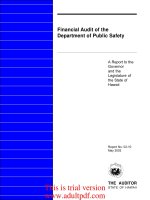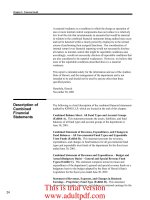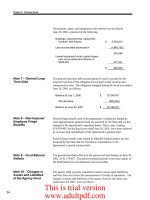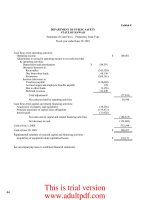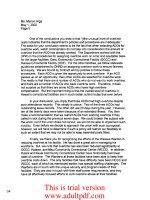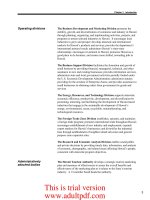Financial Audit of the Housing and Community Development Corporation of Hawaii A Report to the Governor and the Legislature of the State of Hawaii Report No. 01-14 September 2001_part3 potx
Bạn đang xem bản rút gọn của tài liệu. Xem và tải ngay bản đầy đủ của tài liệu tại đây (36.11 KB, 11 trang )
15
Chapter 2: Internal Control Deficiencies
The mission of the corporation is “to serve as a catalyst to provide
Hawaii’s residents with affordable housing and shelter opportunities in a
balanced and supportive environment.” To accomplish this, the
corporation must ensure that there is an adequate number of well-
maintained affordable units available to Hawaii residents. The current
and projected unit inventory does not provide an adequate supply for
Hawaii residents.
As of July 31, 2000, we found that there were approximately 7,200 and
5,800 applicants on the waiting list for low-income public housing and
tenant rental assistance, respectively. Applicants may be on the waiting
list for more than one program. The number of applicants awaiting low-
income public housing increased from May 1999 by approximately 850
applicants. The number of applicants awaiting tenant rental assistance
decreased from May 1999 by 900 applicants; however, this was mainly
because applications were no longer being accepted as of April 1999.
For the period May 1999 to July 2000, the corporation was only able to
place 446 applicants in low-income public housing and 235 applicants in
tenant rental assistance units. Based on the number of placements and
new applicants during this period, it appears that the backlog will
continue to increase each year.
The ability to place applicants in the low-income public housing and
tenant rental assistance programs are based on several factors such as the
requirements of the applicants and their ability to search for housing, the
availability of public and private low-income housing and funding for
tenant rental assistance, the rental market, and general economic
conditions. In 1997, the corporation made a significant policy shift in
how it addresses the availability of low-income public housing. Instead
of directly undertaking development projects, the corporation took on the
role of a housing facilitator, assisting private developers and nonprofit
entities in providing affordable housing in Hawaii through loans and tax
credits. The policy change was in response to the general housing
market, the associated development risks, and the availability of
resources. As a result, the last state low-income public housing project
that was completed by the corporation was in 1995. We found that the
corporation facilitated the completion of only one project totaling 99
units in fiscal year 2000. Moreover, the corporation projects the
completion in fiscal years 2001 and 2002 of two and eight projects,
respectively, totaling 159 and 549 units, respectively. By 2002, a total of
807 additional units are planned; however, as of July 2000, there were
7,200 applicants on the waiting list for low-income public housing, and
the list continues to grow. It appears that the housing shortage will not
be alleviated in the next few years and applicants will continue to wait
for available housing. Furthermore, corporation personnel estimate that
The Corporation
Has Not Been
Entirely
Successful in
Fulfilling its
Corporate Mission
This is trial version
www.adultpdf.com
16
Chapter 2: Internal Control Deficiencies
the current backlog results in a waiting period of two to seven years.
This waiting period is a clear indication that the corporation has not been
entirely successful in fulfilling its corporate mission.
We recommend that the corporation monitor its current and future
projects to ensure that they are efficiently and effectively completed;
develop methods to spur facilitated developments and assist in the
placement of applicants in tenant rental-assisted units; and review
staffing workloads and processes to ensure efficiency and effectiveness.
The corporation receives a substantial amount of funds, approximately
$17.1 million in fiscal year 2000, under the Comprehensive Grant
Program administered by HUD. These funds are used to upgrade and
preserve the corporation’s federal housing projects. As a participant in
this program, Section 968.330 of Title 24 of the Code of Federal
Regulations and the HUD Comprehensive Grant Program Handbook
require that the corporation file an annual performance and evaluation
report summarizing the status of all open grants by September 30 for
each year. If HUD does not record the receipt of the report within 30
days after the due date of September 30, payments to the corporation will
be automatically suspended for the respective grants.
Because of the significant amount of funding received from this program
as well as other programs administered by HUD, it is imperative that the
corporation file required reports within their respective time deadlines.
We found that the corporation failed to comply with the performance and
evaluation report filing deadline for September 30, 1999. We were
informed by corporation personnel that HUD was notified prior to
September 30, 1999, that the corporation would not file the required
report on time. HUD’s response was that the corporation had 30 days
after September 30 to file the report. However, we found that the report
was submitted to HUD on November 11, 1999. While federal guidelines
clearly state that grant funds are automatically suspended for the period
subsequent to October 30, it appears that no grant funds were actually
frozen as the corporation did not receive any notification from HUD.
Fortunately, there were no requests to draw on grant funds during this
period. Nonetheless, a prolonged “freeze” could severely hinder the
corporation’s ability to effectively and efficiently manage its resources.
We recommend that the corporation adhere to HUD reporting
requirements and ensure that staff who are involved with completion of
the reports are aware of the significance of the time deadlines.
Recommendation
The Delay in the
Submittal of a
Required Report
Could Have
Resulted in a
“Freeze” of
Federal Financial
Assistance
Recommendation
This is trial version
www.adultpdf.com
17
Chapter 2: Internal Control Deficiencies
The corporation’s petty cash operations do not ensure internal controls to
deter misuse or misappropriation. The corporation’s petty cash
custodian maintains a petty cash fund in an amount of $500 which is
used for cash reimbursements less than $25. The fund is replenished
when the balance falls below $200, which occurs approximately three
times per year. Disbursements from the petty cash fund must be
supported by original receipts and approved by the petty cash custodian,
the employee receiving the reimbursement, and an accountant. The petty
cash custodian reconciles the cash and original receipts when
replenishment requests are made.
The custodial and reconciliation functions of petty cash funds should be
separated to prevent misappropriation of assets. We found that the
corporation’s procedures lack monthly reconciliations and reviews of the
petty cash fund by an employee independent of the custodial function.
Currently, the petty cash custodian performs both the custodial and
reconciliation functions. In previous years, a corporation employee
independent of the process performed periodic reviews of the petty cash
fund. No irregularities were found. As a result of past experience and
limited personnel resources, the corporation discontinued these periodic
reviews. However, the handling of cash provides the opportunity for
misappropriation and appropriate internal controls should be established
to deter any misappropriation of assets.
We recommend that the reconciliation of the petty cash fund or periodic
reviews of the reconciliation procedures be performed by an employee
independent of the petty cash process.
The Corporation’s
Internal Controls
Over the Handling
of Petty Cash
Could Be
Improved
Recommendation
This is trial version
www.adultpdf.com
18
Chapter 2: Internal Control Deficiencies
This page intentionally left blank.
This is trial version
www.adultpdf.com
19
Chapter 3: Financial Audit
Chapter 3
Financial Audit
This chapter presents the results of the financial audit of the Housing and
Community Development Corporation of Hawaii, State of Hawaii
(corporation) as of and for the fiscal year ended June 30, 2000. This
chapter includes the independent auditors’ report and the report on
compliance and on internal control over financial reporting based on an
audit of financial statements performed in accordance with Government
Auditing Standards as they relate to the corporation. It also displays the
corporation’s combined financial statements together with explanatory
notes and supplementary information.
In the opinion of KPMG LLP, based on their audit, the combined
financial statements present fairly, in all material respects, the financial
position of the corporation as of June 30, 2000, and the results of its
operations and the cash flows of its proprietary fund types for the year
then ended in conformity with accounting principles generally accepted
in the United States of America. KPMG LLP noted certain matters
involving the corporation’s internal control over financial reporting and
its operations that the firm considered to be reportable conditions.
KPMG LLP also noted that the results of its tests disclosed no instances
of noncompliance that are required to be reported under Government
Auditing Standards.
The Auditor
State of Hawaii:
We have audited the accompanying combined financial
statements of the Housing and Community Development
Corporation of Hawaii, State of Hawaii (corporation) as of and
for the year ended June 30, 2000. These combined financial
statements are the responsibility of the corporation’s
management. Our responsibility is to express an opinion on
these combined financial statements based on our audit.
We conducted our audit in accordance with auditing standards
generally accepted in the United States of America and the
standards applicable to financial audits contained in Government
Auditing Standards, issued by the Comptroller General of the
United States. Those standards require that we plan and perform
Summary of
Findings
Independent
Auditors’ Report
This is trial version
www.adultpdf.com
20
Chapter 3: Financial Audit
the audit to obtain reasonable assurance about whether the
financial statements are free of material misstatement. An audit
includes examining, on a test basis, evidence supporting the
amounts and disclosures in the financial statements. An audit
also includes assessing the accounting principles used and
significant estimates made by management, as well as evaluating
the overall financial statement presentation. We believe that our
audit provides a reasonable basis for our opinion.
As discussed in note A to the combined financial statements, the
combined financial statements of the corporation are intended to
present the financial position, results of operations, and cash
flows of only that portion of the funds and account groups of the
State of Hawaii that is attributable to the transactions of the
corporation.
In our opinion, the combined financial statements referred to
above present fairly, in all material respects, the financial
position of the Housing and Community Development
Corporation of Hawaii, State of Hawaii as of June 30, 2000, and
the results of its operations and the cash flows of its proprietary
fund types for the year then ended in conformity with accounting
principles generally accepted in the United States of America.
In accordance with Government Auditing Standards, we have
also issued our report dated December 8, 2000 on our
consideration of the corporation’s internal control over financial
reporting and on our tests of its compliance with certain
provisions of laws, regulations, contracts, and grants. That
report is an integral part of an audit performed in accordance
with Government Auditing Standards and should be read in
conjunction with this report in considering the results of our
audit.
Our audit was performed for the purpose of forming an opinion
on the combined financial statements of the corporation taken as
a whole. The supplementary information included in Schedules
I through IX is presented for purposes of additional analysis and
is not a required part of the combined financial statements. Such
information has been subjected to the auditing procedures
applied in our audit of the combined financial statements and, in
our opinion, is fairly stated in all material respects in relation to
the combined financial statements taken as a whole.
Honolulu, Hawaii
December 8, 2000
This is trial version
www.adultpdf.com
21
Chapter 3: Financial Audit
The Auditor
State of Hawaii:
We have audited the combined financial statements of the
Housing and Community Development Corporation of Hawaii,
State of Hawaii (corporation), as of and for the fiscal year ended
June 30, 2000, and have issued our report thereon dated
December 8, 2000. We conducted our audit in accordance with
auditing standards generally accepted in the United States of
America and the standards applicable to financial audits
contained in Government Auditing Standards, issued by the
Comptroller General of the United States.
Compliance
As part of obtaining reasonable assurance about whether the
corporation’s combined financial statements are free of material
misstatement, we performed tests of its compliance with certain
provisions of laws, regulations, contracts, and grants, including
applicable provisions of the Hawaii Public Procurement Code
(Chapter 103D of the Hawaii Revised Statutes) and procurement
rules, directives, and circulars, noncompliance with which could
have a direct and material effect on the determination of
combined financial statement amounts. However, providing an
opinion on compliance with those provisions was not an
objective of our audit and, accordingly, we do not express such
an opinion. The results of our tests disclosed no instances of
noncompliance that are required to be reported under
Government Auditing Standards. However, we noted an
immaterial instance of noncompliance that we have reported to
the Auditor, State of Hawaii, in Chapter 2 of this report.
Internal Control Over Financial Reporting
In planning and performing our audit, we considered the
corporation’s internal control over financial reporting in order to
determine our auditing procedures for the purpose of expressing
our opinion on the combined financial statements and not to
provide assurance on the internal control over financial
reporting. However, we noted certain matters involving the
internal control over financial reporting and its operation that we
consider to be reportable conditions. Reportable conditions
involve matters coming to our attention relating to significant
deficiencies in the design or operation of the internal control
over financial reporting that, in our judgment, could adversely
affect the corporation’s ability to record, process, summarize,
Report on
Compliance and
on Internal Control
Over Financial
Reporting Based
on an Audit of
Financial
Statements
Performed in
Accordance with
Government
Auditing
Standards
This is trial version
www.adultpdf.com
22
Chapter 3: Financial Audit
and report financial data consistent with the assertions of
management in the financial statements. Reportable conditions
are described in Chapter 2 of this report.
A material weakness is a condition in which the design or
operation of one or more of the internal control components does
not reduce to a relatively low level the risk that misstatements in
amounts that would be material in relation to the financial
statements being audited may occur and not be detected within a
timely period by employees in the normal course of performing
their assigned functions. Our consideration of the internal
control over financial reporting would not necessarily disclose
all matters in the internal control that might be reportable
conditions and, accordingly, would not necessarily disclose all
reportable conditions that are also considered to be material
weaknesses. However, we believe that none of the reportable
conditions described above are material weaknesses.
This report is intended solely for the information of the Auditor,
State of Hawaii, and the management and the Board of Directors
of the corporation and is not intended to be and should not be
used by anyone other than these specified parties.
Honolulu, Hawaii
December 8, 2000
The following is a brief description of the combined financial statements
and supplementary information audited by KPMG LLP, which are
located at the end of this chapter.
Combined Balance Sheet – All Fund Types and Account Groups
(Exhibit A). This statement presents the assets, liabilities, and equity of
all fund types and account groups of the corporation at June 30, 2000.
Combined Statement of Revenues, Expenditures, and Changes in
Fund Balances – All Governmental Fund Types and Expendable
Trust Funds (Exhibit B). This statement presents the revenues,
expenditures, and changes in fund balances for all governmental fund
types and expendable trust funds of the corporation for the fiscal year
ended June 30, 2000.
Description of
Combined
Financial
Statements and
Supplementary
Information
Combined financial
statements
This is trial version
www.adultpdf.com
23
Chapter 3: Financial Audit
Combined Statement of Revenues and Expenditures – Budget and
Actual (Budgetary Basis) – General and Special Revenue Fund
Types (Exhibit C). This statement compares actual revenues and
expenditures of the corporation’s general and special revenue funds on a
budgetary basis to the budget adopted by the State Legislature for the
fiscal year ended June 30, 2000.
Combined Statement of Revenue and Expenses – Proprietary Fund
Types (Exhibit D). This statement presents the revenue and expenses
for all proprietary fund types of the corporation for the fiscal year ended
June 30, 2000.
Combined Statement of Fund Equity – Proprietary Fund Types
(Exhibit E). This statement presents the changes in fund equity for all
proprietary fund types of the corporation for the fiscal year ended
June 30, 2000.
Combined Statement of Cash Flows – Proprietary Fund Types
(Exhibit F). This statement presents the cash flows from operating, non
capital financing, capital and related financing, and investing activities
for all proprietary fund types of the corporation for the fiscal year ended
June 30, 2000.
Combining Balance Sheet – Special Revenue Funds (Schedule I).
This schedule presents the assets, liabilities, and fund balances (deficit)
of the special revenue funds of the corporation at June 30, 2000.
Combining Statement of Revenues, Expenditures, and Changes in
Fund Balances (Deficit) – Special Revenue Funds (Schedule II). This
schedule presents the revenues, expenditures, and changes in fund
balances (deficit) of the special revenue funds of the corporation for the
fiscal year ended June 30, 2000.
Combining Balance Sheet – Enterprise Funds (Schedule III). This
schedule presents the assets, liabilities, and fund equity of the enterprise
funds of the corporation at June 30, 2000.
Combining Statement of Revenues and Expenses – Enterprise Funds
(Schedule IV). This schedule presents the revenues and expenses of the
enterprise funds of the corporation for the fiscal year ended June 30,
2000.
Combining Statement of Changes in Fund Equity – Enterprise
Funds (Schedule V). This schedule presents the changes in fund equity
of the enterprise funds of the corporation for the fiscal year ended
June 30, 2000.
Supplementary
information
This is trial version
www.adultpdf.com
24
Chapter 3: Financial Audit
Combining Statement of Cash Flows – Enterprise Funds
(Schedule VI). This schedule presents the cash flows from operating,
non-capital financing, capital and related financing, and investing
activities of the enterprise funds of the corporation for the fiscal year
ended June 30, 2000.
Combining Balance Sheet – Revenue Bond Funds (Schedule VII).
This schedule presents the assets, liabilities, and fund equity (deficit) of
the revenue bond funds of the corporation at June 30, 2000.
Combining Statement of Revenues, Expenses, and Changes in
Retained Earnings (Accumulated Deficit) – Revenue Bond Funds
(Schedule VIII). This schedule presents the revenues, expenses, and
changes in retained earnings (accumulated deficit) of the revenue bond
funds of the corporation for the fiscal year ended June 30, 2000.
Combining Statement of Cash Flows – Revenue Bond Funds
(Schedule IX). This schedule presents the cash flows from operating,
non-capital financing, capital and related financing, and investing
activities of the revenue bond funds of the corporation for the fiscal year
ended June 30, 2000.
Explanatory notes which are pertinent to an understanding of the
combined financial statements and financial condition of the Housing
and Community Development Corporation of Hawaii, State of Hawaii
(corporation) are discussed in this section.
General
Chapter 201E, Hawaii Revised Statutes (HRS) and Act 337, Session
Laws of Hawaii (SLH) 1987, created the Housing Finance and
Development Corporation (HFDC). The HFDC was created to perform
housing finance, housing development, and residential leasehold
functions. The Hawaii Housing Authority, State of Hawaii (HHA) was
organized pursuant to the provisions of Chapter 356, HRS. The HHA
was created to provide safe and sanitary dwelling accommodations for
low and moderate income residents of Hawaii.
In accordance with Act 350, SLH, 1997, effective July 1, 1998, the
functions and employees of HFDC as well as those of the HHA and the
Rental Housing Trust Fund (RHTF) were transferred to the newly
created corporation. The purpose of Act 350, SLH, 1997, was to
consolidate all state housing functions previously administered by the
HHA, the HFDC, and the RHTF. The corporation is a public body and a
Notes to
Combined
Financial
Statements
Note A – Organization
and Significant
Accounting Policies
This is trial version
www.adultpdf.com
25
Chapter 3: Financial Audit
body corporate and politic and is, for administrative purposes only,
considered to be a part of the state Department of Business, Economic
Development and Tourism.
For financial reporting purposes, the corporation includes all funds and
account groups that are controlled by or dependent on the corporation’s
Board of Directors. Control by or dependence on the corporation was
determined on the basis of statutory authority and monies flowing
through the corporation to each fund or account group.
HUD Subsidized Programs
The Federal Low-Rent Program and the various Section 8 funds are
referred to collectively as the HUD Subsidized Programs and represent
the contracts that the corporation has entered into with the U.S.
Department of Housing and Urban Development (HUD). The Federal
Low-Rent Program is used to account for corporation-owned housing
projects that are rented to low-income families. To provide for the
development and modernization of low-rent housing units, the
corporation issues housing bonds and permanent notes. These bonds and
notes are payable by HUD and secured by annual contributions (note L).
HUD Subsidized Programs also include subsidized housing assistance
payments. Under these programs, low-income tenants lease housing
units directly from private landlords rather than from the corporation.
Rental payment subsidies are paid directly to the private landlords by the
corporation using operating subsidies obtained from HUD.
The Federal Low-Rent Program includes all property and equipment,
principally structures and improvements, acquired with the proceeds
from notes and bonds collateralized by HUD.
Significant Accounting Policies
The accounting policies of the corporation utilized in the accompanying
combined financial statements conform to generally accepted accounting
principles (GAAP) applicable to governments as prescribed by the
Governmental Accounting Standards Board through its statements and
interpretations. The following is a summary of the significant
accounting policies.
1. Basis of Presentation
The financial transactions of the corporation are recorded in
individual funds and account groups that are reported by type in the
combined financial statements. The corporation accounts for and
reports only its portion of those fund types and account groups
This is trial version
www.adultpdf.com
